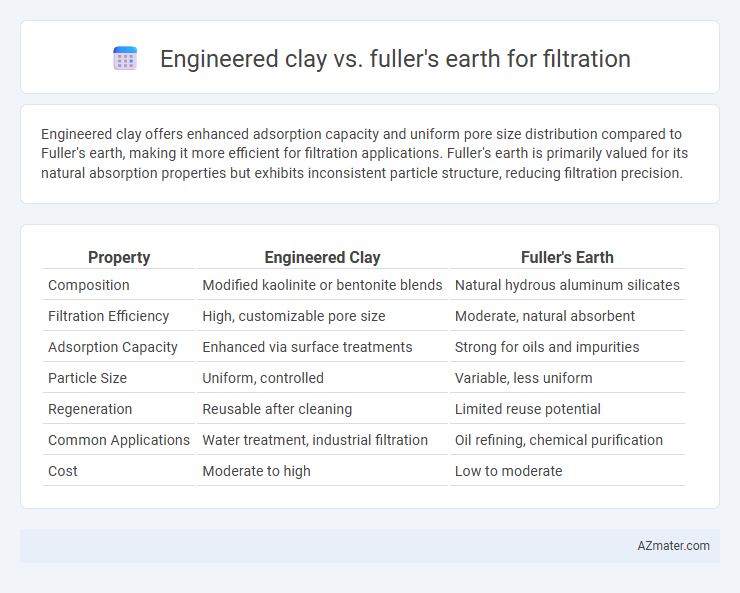Engineered clay offers enhanced adsorption capacity and uniform pore size distribution compared to Fuller's earth, making it more efficient for filtration applications. Fuller's earth is primarily valued for its natural absorption properties but exhibits inconsistent particle structure, reducing filtration precision.
Table of Comparison
| Property | Engineered Clay | Fuller's Earth |
|---|---|---|
| Composition | Modified kaolinite or bentonite blends | Natural hydrous aluminum silicates |
| Filtration Efficiency | High, customizable pore size | Moderate, natural absorbent |
| Adsorption Capacity | Enhanced via surface treatments | Strong for oils and impurities |
| Particle Size | Uniform, controlled | Variable, less uniform |
| Regeneration | Reusable after cleaning | Limited reuse potential |
| Common Applications | Water treatment, industrial filtration | Oil refining, chemical purification |
| Cost | Moderate to high | Low to moderate |
Introduction to Filtration with Natural Clays
Natural clays such as engineered clay and Fuller's earth play a crucial role in filtration due to their high adsorption capacity and porous structure. Engineered clay is synthetically modified to enhance specific filtration properties, including improved particle retention and chemical resistance, making it ideal for industrial water treatment. Fuller's earth, a naturally occurring clay, effectively removes impurities like oils and heavy metals through its strong adsorptive abilities and layered mineral composition, widely used in environmental and cosmetic applications.
Engineered Clay: Composition and Properties
Engineered clay for filtration primarily consists of a highly purified kaolinite or montmorillonite matrix, with controlled particle size distribution and enhanced adsorption capabilities tailored for specific contaminants. Its dense microstructure and stable chemical properties offer superior retention of impurities compared to Fuller's earth, which is naturally occurring and less uniform in composition. Engineered clay's high cation-exchange capacity and thermal stability make it ideal for advanced filtration applications in water treatment and industrial processes.
Fuller’s Earth: Overview and Key Characteristics
Fuller's earth is a highly absorbent clay material renowned for its exceptional ability to filter oils, impurities, and contaminants in various industrial and environmental applications. Compared to engineered clay, Fuller's earth possesses a unique mineral composition primarily consisting of montmorillonite, giving it superior adsorptive properties and a highly porous structure. Its cost-effectiveness, natural abundance, and efficiency in removing organic compounds make it a preferred choice in filtration systems focused on water purification and oil refining.
Filtration Efficiency: Engineered Clay vs Fuller’s Earth
Engineered clay exhibits superior filtration efficiency compared to Fuller's earth due to its tailored pore size distribution and enhanced adsorption capacity, allowing it to effectively remove fine particulates and contaminants. Fuller's earth, while naturally absorbent, often has variable mineral content and pore structure that result in less consistent filtration performance. Optimized engineered clay materials achieve higher contaminant retention rates, making them more reliable for industrial and water purification applications.
Adsorption Capacities Compared
Engineered clay exhibits higher adsorption capacities for removing heavy metals and organic contaminants compared to Fuller's earth due to its tailored porous structure and enhanced surface area. Fuller's earth, predominantly composed of smectite clays, effectively adsorbs oils and grease but shows lower affinity towards certain pollutants relative to engineered clay variants. Optimizing the adsorption properties of engineered clay through modifications like ion exchange and surface activation significantly improves filtration efficiency for water and air purification applications.
Cost Analysis: Engineered Clay vs Fuller’s Earth
Engineered clay offers a consistent adsorption capacity with lower impurity levels, resulting in enhanced filtration efficiency compared to Fuller's earth, which varies in quality due to natural deposits. The production cost of engineered clay is typically higher due to processing and modification steps, but it often reduces operational expenses by improving filter lifespan and reducing maintenance frequency. Fuller's earth presents a lower upfront material cost but may incur higher long-term costs through frequent replacement and variable filtration performance.
Environmental Impact and Sustainability
Engineered clay demonstrates superior environmental sustainability compared to Fuller's earth due to its lower extraction impact and enhanced reusability in filtration processes, reducing the need for frequent replacement. Fuller's earth mining often leads to significant land degradation and loss of biodiversity, whereas engineered clay can be synthetically produced or refined with minimal ecological disturbance. The lifecycle analysis of engineered clay shows a smaller carbon footprint and better potential for recycling, making it a more sustainable choice for filtration applications.
Applications in Water and Oil Filtration
Engineered clay exhibits superior adsorption capacity and chemical stability, making it highly effective for removing heavy metals and organic contaminants in water filtration systems. Fuller's earth, known for its strong oil absorption and decolorizing properties, is widely used in oil filtration to purify lubricants and edible oils. Both materials enhance filtration efficiency, with engineered clay preferred in wastewater treatment and Fuller's earth dominating in refining and degumming processes.
Regeneration and Reusability
Engineered clay offers superior regeneration and reusability in filtration due to its tailored pore structure and enhanced adsorption capacity, allowing multiple cycles without significant loss of performance. Fuller's earth, while naturally abundant and cost-effective, often requires more intensive regeneration processes such as thermal or chemical treatments, which can degrade its adsorption efficiency over time. The engineered clay's durability and consistent structural integrity make it more suitable for applications demanding frequent regeneration and long-term reuse.
Choosing the Right Clay for Your Filtration Needs
Engineered clay offers consistent particle size and high purity, enhancing filtration efficiency by trapping fine contaminants more effectively than Fuller's earth. Fuller's earth is naturally abundant with a broader particle distribution, ideal for general filtration but less precise in removing micro-pollutants. Selecting the right clay depends on required filtration precision, contaminant type, and application scale, with engineered clay excelling in specialized, high-performance filtration systems.

Infographic: Engineered clay vs Fuller’s earth for Filtration
 azmater.com
azmater.com